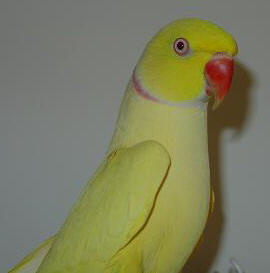Parakeet - Indian Ringneck
Indian Ringneck Parrot Scientific Name: Psittacula krameri manillensis
Mon, 30th June, 2025 - 8:24 pm GMT
Sponsor Ads:

Alternative Name
Indian Ringneck Parrot Scientific Name: Psittacula krameri manillensisBasic Info
The Indian Ringneck is sometimes confused with other Ringneck species. The Indian Ringneck is larger than the African Ringneck and has a larger tail. The Indian Ringneck usually measures 16 inches in length, whereas the African Ringneck averages a mere 14 inches. The African Ringneck also has a longer tail than the Indian Ringneck. The Neumann's Ringneck is a little larger than the Indian and is reported to be slightly more aggressive. In general the Indian Ringneck has darker plumage than the nominate form (the African Ringneck), and its ring-neck is also darker and more prominent. Mature male and female Indian Ringnecks can be distinguished visually. Males have a largely dark green plumage with yellow-green feathers appearing under the wing covets. They have wide black bands on their cheeks and black chins. True to their names, they have a rose pink ring on the back of their necks. The females do not have the black markings on their cheeks or chin and are lacking the pink ring. Immatures can be easily distinguished by their grey eyes, and otherwise they largely resemble the females. In addition to the normal wild type there are an enormous number of color mutations among Indian Ringnecks, including lutino, blue, and turquoise. The beautiful color patterns may contribute to their popularity as pets. They may be as many as 50 to 100 different mutations!
Health
The Indian Ringneck is not difficult to care for in captivity, but if they are kept singly as pets, they require a lot of attention to maintain their tameness. They are avid chewers and toys must be provided to prevent destructive behavior. Some Indian Ringnecks do not enjoy bathing. If your Indian Ringneck does not like to bathe it should be misted weekly. Some Indian Ringnecks do love to bathe, however, and individuals that do enjoy water should be provided baths frequently. Breeding The Indian Ringneck male will reach sexual maturity at approximately 18 months, but males may not breed for as long as 3 years. Indian Ringneck Parakeets are bred regularly in captivity. If you keep your breeding pairs in group aviaries, some aviculturists advise separating pairs before breeding and leaving them separated from the group throughout the breeding season, as they may become aggressive at this time. In captivity the breeding season of the Indian Ringneck is variable. If your aviary is indoors they will usually begin breeding in December. In outdoor aviaries some pairs may breed as early as February, and this can be a problem. In order to avoid early breeding (which may cause egg binding) it is suggested that nest boxes be removed until April. The average clutch size is 3 to 5 eggs. The incubation period lasts an average of 23 days, with babies fledging in 7 weeks.Habitat
Found in forests and savannahs, they are also not uncommon in urban areasBehavior
Ringneck Parakeets are growing in popularity among aviculturists and pet lovers around the globe, and the Indian Ringneck is the most popular of them all among hobbyists. They are considered elegant and beautiful by fanciers. Like all Ringneck Parakeets the Indian Ringneck is easy to teach and tame. These beautiful birds are also quite hardy making them favorites for novice and expert hobbyists alike. Of all the Ringnecked Parakeets, the Indian is perhaps the most popular and widely available. It is for this reason that many of the other subspecies are confused with it. Unlike some parrots, parent-raised babies are easily tamed, and hand-feeding is not required to produce a tame loving pet. Instead socialization and regular handling combined with lots of attention and time is the key. Regular handling is needed to maintain your tamed Ringneck's friendly personality. If they are not given the proper amount of attention, they may grow unfriendly and can become nippy. These are social birds, and in the wild they live in groups. For this reason they must have plenty of attention given to them every day, particularly if they are kept singly. Some have reported that males make better pets, but others report that females make equally good pets provided they receive enough love and attention. Some Ringnecks make excellent talkers, though this is never a guarantee. All of the Ringnecks are highly intelligent and require plenty of toys to keep the stimulated. They also enjoy chewing, so chew toys are a must. Some Indian Ringnecks learn to talk, though this is not the norm. The average lifespan of an Indian Ringneck in captivity is between 25 and 30 years.Origin
IndiaHistory
Indian Ringnecks are most commonly found in the open areas of India, but they are also found in Burma, Nepal, Bangladesh, Pakistan, and on the Rameswaram Island. In addition to being found in forests and savannahs, they are also not uncommon in urban areas. They became popular as pets hundreds of years ago and their popularity seems to be increasing with time. It has even been reported that pet Indian Ringnecks were documented as far back as 200 B.C. by Archimedes.Common Foods
These birds love fruits and veggies, and they should be given access to both daily.Sponsor Ads:
Half of conversation is listening. -- Unknown
Parakeet - Indian Ringneck
Coded by: BGID® | ALL RIGHTS RESERVED Copyright © 2000-2025
Disclaimer | Privacy | Report Errors / Contact | Credits
















